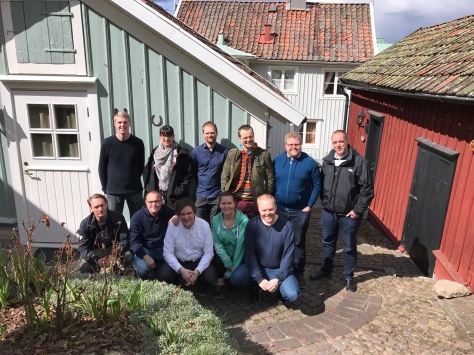TL DR: Peer conferences are really great, go to one if you have the chance.
After having participated in various larger conferences such as Eurostar, Let´s Test and SAST, it was now time for something different: a peer conference named SWET. This was the 8th incarnation of the conference and hopefully there will be many more. This time, eleven testers from all over the country (well, if you count Örebro to the north) met in Gränna to discuss testing over an intense weekend. Or wait, the people were not really testers, and we were not really talking about testing, or were we? The theme for the conference was “Testing that is not testing” and derived from the fact the organisers found that they had moved on to roles where they were not testing anymore, but rather worked with coaching, managing or facilitating testing. So the idea was to discuss testing related things that are not actually test execution. The format of the SWET conference is very much based on facilitated in-depth discussions, and each discussion is kicked off with a presentation from one of the participants. Another core concept of the conference is that it is heavily experience based, and that was reflected in the presentations which all had clear connections to something the presenter had worked with and experienced first hand.

The first presentation was “How to understand other peoples´understanding” by David Högberg. David talked about how he as a new tester at a bank using some whiteboard drawings and well targeted questions sparked discussions that revealed over-simplifications and misunderstandings regarding the functionality of the project. He also talked about how he at another place visualised his test progress in realtime on a mindmap displayed at his desk. This turned out to be a powerful tool for the common understanding in the team regarding test progress and state of the product. The common theme of the presentation was centered around the power of visualisation and using “ignorance as a superpower”, this by enabling open and fundamental questions. The discussions that followed covered such topics as (and much more):
- How to enable experienced people to ask about basic stuff they think they are already supposed to know about?
- When and how to ask questions about what is being/has been developed. Throwing risks and “have you thought about this?” at people might be received very differently depending on context and timing.
- How to combine experienced and non-experienced testers in a good way to enable growth and getting multiple perspectives. The same question was also applied to technical and non-technical testers.
- What to we actually mean when we are talking about non-technical testers?
- How to visualise complex realities with mind maps, and also how to collaborate around them and keeping them “alive”.
- Why mind maps aren´t always the best option and that it is important to take one step back and think about the best way to visualise the model you have in mind.
The second presentation was “How I got the whole team to test” by Anna Elmsjö. Anna talked about her experience joining a couple of established teams that previously had no testers. She described the challenge of establishing the concept of testing in that team and how she step by step gained the trust of the team and made them try out new things. Some of the discussion/questions after the presentation revolved around:
- Testing environments and testing in production.
- Important things when scoping out and facilitating test sessions. How to make people keep focus etc.
- Will quality suffer when testing is handled by non-testers?
- How automation was utilised in that context.
- How to visualise and represent testing on scrum boards etc.
- The importance of finding allies when promoting change.
- Disaster recovery in production.
The third and last presentation second day of the conference. The presentation was named “Flow visualisation and LEAN” and was held by Joel Rydén. Joel talked about his experience in change management as part of establishing a new cloud solution. He described how a common language was established early by identifying and defining values, principles, methods and tools. One other important part was also looking at the whole chain from idea to delivery and trying to identify waste (stuff not adding value). Some interesting discussions and takeaways that sparked from that presentation:
- How quality might not be the best word to use as a value, it is often too broad and relative concept. It might be a better idea to focus on a certain quality characteristic instead.
- Focusing on removing waiting time is important to increase speed. One common mistake is to measure WIP limit over just one column instead of all columns.
- Once again how powerful it is to visualise things. In his context, Joel had used Jira to display a real-time picture of at what stage in the process different tasks were located. This enabled them to monitor and tweak as time went on.
In addition to the main presentations there were also a round of lightning talks followed by very brief, time boxed discussions:
- Martin Jansson talked about the quality coach role and the risks that he perceived might come with it when testers take a step back from testing.
- Sigge Birgisson talked about “Safety instructions for developers”. It was a story about how he made the expectations on testing for developers explicit by providing them heuristics on what to test.
- Erik Brickarp followed up on Sigges talk by providing his experiences around the same topic.
- David Högberg explored the topic on why failing is good and if you can learn anything from success.
- Carita Jansson Tsiantes provided the question of the difference between testing and quality assurance, and what the words meant. A topic that has been widely discussed before but got some really good and nuanced opinions in this discussion.
So that was a short (relative to the actual length) summary of the presentations and discussions that were held at SWET8, and this was just the scheduled conference part. There were many more interesting (and more philosophical) discussions and testing anecdotes in the evenings, and for some people, late in the night. That is all a great part of the fun of peer conferencing. I want to give a special shoutout to the organisers Erik Brickarp, Sigge Birgisson and Göran Bakken for the excellent job of setting this up. The topic could not have been more appropriate either for me personally, since I have recently found myself doing more work around testing than actual testing. I got many takeaways and things to follow up that I will take with me and nourish in my future work. I plan to create a second blog post with all the studying tips I got in form of books, presentations and other various stuff during the weekend, so stay tuned.

For the future, I can only hope to get the opportunity to participate in more of these kinds of conferences, because they rock.
Thank you and you’re welcome .)
This is once again a reminder that we need to organize these conferences more often than once every two years…
I always appreciate people’s blog posts from these kind of events, great reminder and since we don’t react to the same thing/interpret everything the same there’s always new stuff to learn even though I was there. I like this post a lot Hannes, simply because there are things from all the three sessions you covered that I didn’t write down myself.
My goal right now is one SWET this autumn and then one next spring and that I don’t attend both so that more new people may attend instead (I gladly help but I’ll try to only attend/co-organize one of them .)